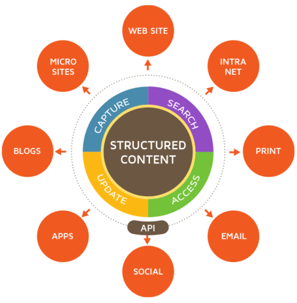The user expectations in this digital world are soaring higher to get an impressive user experience on the channel of their choice. Decoupling approach empowers Drupal in making applications which are future-ready, can be exposed on various channels, and have faster user request-response time.
All web content management (WCM) solutions can handle content traditionally, however, when headless, they don’t handle presentation at all. The one WCM that stands out amongst others is the one that is the most flexible, future-ready, poses minimum risks and utilizes the skills of both frontend and backend developers. However, the most typical questions remain when and why should we decouple?
Understand When Should You Decouple
To help identify when decoupling is required, it is important to understand what is the purpose behind it. The following questions should be asked before thinking to implement Decoupled approach:
- Will the content be presented on multiple platforms (like web, mobile, IoT, etc.)?
- Is the website required to be scalable?
- Is the team competent enough to implement a complex architecture approach?
- Is it one of the requirements to expose data through a particular technology?
If you answered yes to all of the above questions, then you now know that you must opt-in for the decoupled architecture.
But are these questions enough for a technical decision maker to consider while deciding to go for decoupling the site or not and whether the effort is worth the risk? Will the RoI be more than what was invested to implement the approach?
Let’s take a look at what are other factors that should be part of the decision making process.
What To Consider Before Making The Decision?
Look at the below checklist to implement the decoupled approach, only if:
- Team is self-sufficient and consists of Angular/React JS experts and not just Drupal developers
- It’s required to make Drupal the sole owner of data
- Have a hosting provider capable of hosting non-Drupal front-end
- The data needs to be exposed to multiple platforms
Why Decouple - Benefits of Decoupling
A decoupled architecture allows each component to perform its tasks independently by segregating the frontend from backend making their functionality more self-contained. However, let’s look at the advantages of the decoupled architecture to start off with:
-
Publish Reusable Content On Multiple Platforms
Content is expensive to create, hence it’s best to follow a structured content authoring approach (treating each content piece as a separate entity which can be independently updated and can be referenced at multiple places).
Decoupled architecture creates a technical abstract between content management and the website backend. It publishes reusable content that is easier to share on a different channel, maintain and is not hard-wired to the website design.
 Source: digitaldoughnut
Source: digitaldoughnut
-
Every Medium Uses Same APIs
Following the decoupled approach, information is made available to every possible medium with the use of APIs for ingesting content from the website. There’s equal importance given to all channels as each channel uses the same API and no medium is considered to be a second-tier audience. This also means quick and easy content update, customization irrespective of any channel with a more efficient collaboration. -
Fewer Blockers In Development Process
Both the frontend and backend developers can work independently which can lead to the efficient and speedy delivery of a project. While decoupling reduces the dependency of developers on each other, it allows you to have a clean separation of duties. So, once the API has been determined, the frontend and backend can proceed in parallel and independently work to build the site and lead to the efficient and speedy delivery of the project. -
Exceptional Performance Delivered
With a decoupled CMS, you are allowed more flexibility and efficiency of the Drupal content model. When it comes to performance, decoupled Drupal performs well any day and proves to be better than the monolithic approach. With a client-side framework on the presentation layer, instead of Drupal’s, the user’s request to the server time reduces. This improves the user experience as the user gets a quick response to his/her query each time. -
Reduced Future Redesigns and Independent Upgrades
Once you have decoupled your site, you could launch a brand new design without making any back-end changes. Building a new frontend is much less work than rebuilding the whole site. Likewise, the backend changes can be made without requiring front-end changes.
Challenges of Decoupled Approach
Along with merits, decoupling has its own set of demerits too. However, whether the merits outweigh the demerits or not, this is upto you to decide.Let’s discuss them:
- Web of Systems
A decoupled system becomes a host of systems as a whole and figuring out a bug becomes more complicated.
- High Development Cost
It almost always costs more to decouple than to build a traditional site as decoupling requires additional infrastructure and recreating solutions provided by traditional Drupal.
- Complex Architecture
It makes more sense to utilise the much more complex infrastructure stack of decoupled approach when you are building more than just a website, like an API to serve multiple consumers. It has to be ensured that front-end display logic is not encoded in the API so as to avoid deadlocks.
- Time-Consuming Tasks
Some tasks are particularly tricky in a decoupled environment, like a content preview before publishing. It could look completely different than the webpage, and you can’t preview it because you can’t be sure how it will be used.
Concluding
Decoupling has its advantages and disadvantages and is not meant for every website. Between the two the choice should be made with respect to the project in hand, as one may work best in one scenario, while the other may not.
Still unsure?
We understand it can be a little overwhelming to decide. Reach out to us at business@srijan.net and let our experienced Acquia certified Drupal developers help you with your decision.
Our Services
Customer Experience Management
- Content Management
- Marketing Automation
- Mobile Application Development
- Drupal Support and Maintanence
Enterprise Modernization, Platforms & Cloud
- Modernization Strategy
- API Management & Developer Portals
- Hybrid Cloud & Cloud Native Platforms
- Site Reliability Engineering



